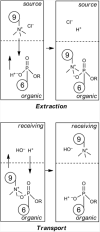Calixarene-Mediated Liquid-Membrane Transport of Choline Conjugates
- PMID: 26161034
- PMCID: PMC4493905
- DOI: 10.1002/ejoc.201400025
Calixarene-Mediated Liquid-Membrane Transport of Choline Conjugates
Abstract
A series of supramolecular calixarenes efficiently transport distinct molecular species through a liquid membrane when attached to a receptor-complementary choline handle. Calix-[6]arene hexacarboxylic acid was highly effective at transporting different target molecules against a pH gradient. Both carboxylic- and phosphonic-acid-functionalized calix[4]arenes effect transport without requiring a pH or ion gradient. NMR binding studies, two-phase solvent extraction, and three-phase transport experiments reveal the necessary and subtle parameters to effect the transport of molecules attached to a choline "handle". On the other hand, rescorin[4]arene cavitands, which have similar guest recognition profiles, did not transport guest molecules. These developments reveal new approaches towards attempting synthetic-receptor-mediated selective small-molecule transport in vesicular and cellular systems.
Keywords: Calixarenes; Cavitands; Choline conjugates; Host-guest systems; Liquid-membrane transport; Molecular recognition.
Figures







References
-
- Langer R. Science. 1990;249:1527–1533. - PubMed
-
- Haag R, Kratz F. Angew Chem Int Ed. 2006;45:1198–1215. - PubMed
- Angew Chem. 2006;118:1218–1237.
-
- Pardridge WM. Drug Discovery Today. 2007;12:54–61. - PubMed
-
- Schramm MP, Hooley RJ, Rebek J. J Am Chem Soc. 2007;129:9773–9779. - PubMed
-
- Hof F, Trembleau L, Ullrich EC, Rebek J. Angew Chem Int Ed. 2003;42:3150–3153. - PubMed
- Angew Chem. 2003;115:3258–3261.
Grants and funding
LinkOut - more resources
Full Text Sources
Other Literature Sources
